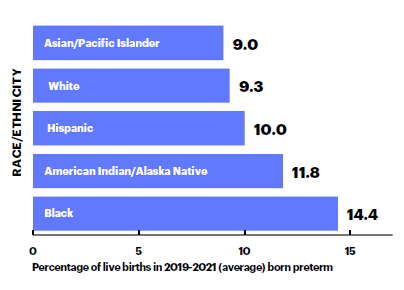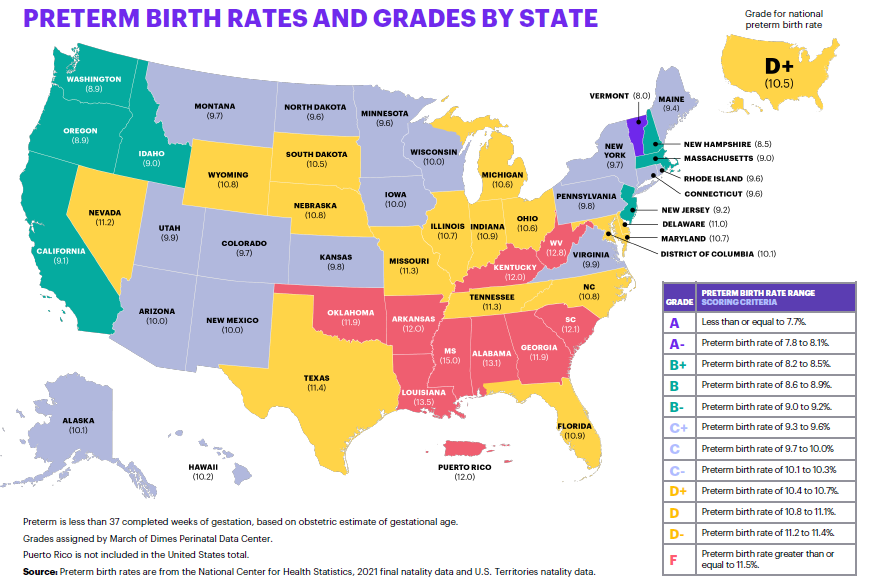
Pre-term Birth Rates Increase Amid Maternal Health Crisis
The average US pre-term birth rate has risen to a 15-year high of 10.5%, according to a recent March of Dimes report.
This finding further highlights the maternal health crisis in the US, where mothers, especially those of color, struggle to access maternal healthcare and are vulnerable to preventable pregnancy-related deaths, including those caused by COVID-19.
How does the high pre-term birth rate impact Latinas and their babies? And what can we do to help?

What is Pre-term Birth?
Pre-term birth occurs when a baby is born before 37 weeks of gestation. Babies need about 40 weeks in the womb to develop before birth, according to March of Dimes.
About one out of every 10 births in the US is premature, according to the Cleveland Clinic.
Black and American Indian/Alaskan Native women have historically suffered the highest pre-term birth rates (14.4% and 11.8%, respectively), with Latinas having the third-highest rate based on ethnicity (10%), according to March of Dimes.
Certain risk factors and health inequities, such as lack of access to healthcare, may play a role in a woman’s likelihood of delivering early.
However, many women give birth early with no known risk factors.

Implications of Pre-term Birth
Babies that are born too early can have health complications. These include low body temperature, labored breathing or respiratory distress, and lack of reflexes for sucking and swallowing – which can lead to feeding difficulties, according to the Mayo Clinic.
In fact, complications from pre-term births are the top cause of death in children younger than 5.
There are also risks for pre-term babies to develop long-term health complications, including impaired learning and vision problems.
Premature birth can also cause financial stress for families because their baby may require overnight hospital stays and special medical care.
Additionally, the risk of anxiety, depression, and post-traumatic stress disorder (PTSD) is significantly higher in parents of pre-term babies, according to a 2016 BMJ Open study.
These mental health implications are reported to persist for a considerable time after pre-term birth and can even increase the mother’s risk of negative feelings toward her baby and decrease the likelihood of seeking mental health support and postnatal services.
What States Have the Highest Pre-term Birth Rates?
March of Dimes graded states on an A – F scale, with A being the lowest pre-term birth rates, and F being the highest.
Several states with a high Latino population earned a “D,” including Texas (40.2% Latino), Nevada (29.9% Latino), and Wyoming (10.6% Latino).
States that scored an “F” included:
Oklahoma (11.7% Latino)
Arkansas (8.3% Latino)
Louisiana (5.6% Latino)
Mississippi (3.5% Latino)
Alabama (4.8% Latino)
Georgia (10.2% Latino)
South Carolina (6.4% Latino)
West Virginia (1.9% Latino)
Kentucky (4.2% Latino)
Sadly, the only state to earn an “A” was Vermont (2.2% Latino).

What Do Many of These Low-Scoring States Have in Common?
Many of these states with high pre-term birth rates have not expanded Medicaid, which would help provide affordable health insurance for many low-income mothers, such as Latinas.
Having access to more affordable health insurance could help mothers take better care of their overall health, potentially decreasing their risk for pre-term birth.
Another commonality is the presence of maternity care deserts, where women are more likely to be uninsured and have to travel at least 30 minutes to get maternal health care.
Martha Wingate, professor of health policy and organization at the University of Alabama at Birmingham, is highly concerned for mothers and babies in poorly scored states, including Alabama.
“We are failing moms and babies. Regardless of who you are, if you are pregnant and deliver a baby in Alabama, you are at higher risk of dying, of your baby dying, period,” Wingate told NBC News. “We have places in the state where women live two to three hours from the closest delivery hospitals. Our outcomes shouldn’t look like this. We can do better.”
Promoting Health Equity for All Mothers and Babies
March of Dimes points to several strategies for reducing pre-term birth rates.
As mentioned earlier, Medicaid expansion could help more mothers get the care they need to have a healthy pregnancy and post-partum experience. Only 39 states have expanded Medicaid.
Additionally, extending Medicaid coverage beyond the standard 60 days after pregnancy would help mothers remain insured for up to a year after the birth of their child. Currently, only 26 states have extended Medicaid.
Other policies include supporting Medicaid coverage of midwifery and doula services and establishing a Maternal Mortality Review Committee and Perinatal Quality Collaborative in all 50 states.
March of Dimes also offers several opportunities for you to get involved in promoting maternal health equity, including organizing community walks to raise awareness.
Get involved in a March of Dimes campaign!
You can also promote maternal health equity by selecting your county and getting a Health Equity Report Card by Salud America! at UT Health San Antonio.
In your report card, you will see maps, data, and gauges to compare health equity issues, including access to healthcare and infant mortality, to the rest of your state and nation.
You can email your Health Equity Report Card to local leaders to stimulate community change. Use the data in your materials or share on social media to raise awareness.
Get your Health Equity Report Card!
The post Pre-term Birth Rates Increase Amid Maternal Health Crisis appeared first on Salud America.

